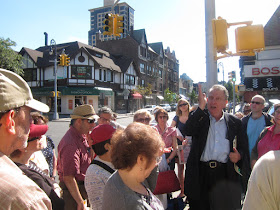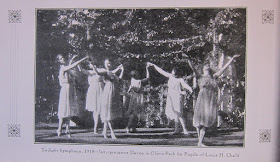This is Michael Perlman's Forest Hills Times/Queens Ledger 10/18/12 article on Historian Jeff Gottlieb, Founder & President of Central Queens Historical Association. On October 14th, he led the Downtown Forest Hills tour, and addressed architectural styles and historic patterns:
http://www.foresthillstimes.com/view/full_story/20541607/article-Jeff-Gottlieb--Historian-Paints-A-Central-Queens-Legacy
Throughout
Forest Hills and Rego Park, as well as much of Central Queens and
beyond, a richly built history with individuals who made an imprint
exists in unique ways. We just need to know where to look, pause
momentarily, and gaze up in midst of busy routines to admire historic
architectural styles above modern storefronts. If feeling inspired
enough, we can also visit archives.
Thanks to the dedication of
historian Jeff Gottlieb, founder and president of Central Queens
Historical Association, the 11th annual Downtown Forest Hills tour took
place on October 14, and the public acquired some excerpts from this
“walking encyclopedia.”
Gottlieb, a resident of Kew Gardens
Hills, was raised in Crown Heights. He is a retired history teacher, who
is currently employed by the Board of Elections. He graduated from
Forest Hills High School and earned a BA and MS in Education at Queens
College.
In the early 1980s, Gottlieb joined Community Board 6,
and felt enriched by the history of Forest Hills. He visited the Long
Island Room of Jamaica’s Central Library, which is home to historic
newspapers, books, and vintage photos.
In 1986, he coordinated
his first Forest Hills tour, which he admits he initially had minimal
knowledge of. His followers increased when weeklies printed local
history articles.
In the 1990s, he conducted lectures and
additional tours, and submitted papers and slideshows to libraries. Some
of his walking tours include Forest Hills Gardens, Rego Park, 108th
Street, Cord Meyer, Kew Gardens, Kew Gardens Hills, Queens College,
Downtown Jamaica, and Richmond Hill.
Some of his bus tours are Jewish Central Queens and “Jazz Trail: From Flushing Town Hall to Addisleigh Park.”
The
Downtown Forest Hills tour encompasses Austin Street on the south,
Ascan Avenue on the east, 70th Avenue on the west, and Queens Boulevard
on the north, and contains commercial and residential developments, as
well as religious buildings.
Notable sites reflect the Tudor,
Georgian Colonial, Colonial, Art Moderne, Tudor Gothic, and
Neo-Renaissance styles. Gottlieb explained historic patterns of the 20th
century business district, distinctive architectural details, and
skillful developers and architects such as Benjamin Braunstein and
Theobald Engelhardt.
Memorable 20th century businesses include
the Forest Hills Theatre, Sutton Hall Pharmacy (a soda-fountain spot),
Beau Brummel, Woolworth’s, Addie Vallens, the Homestead, Cheeses of The
World, and Buster Brown Shoes.
Some of Forest Hills' numerous
notables are Helen Keller, Bud Abbott, Lou Costello, and Geraldine
Ferraro. Non-existent alphabetical street names include DeKoven Street,
Euclid Street, Fife Street, Windsor Place, and Roman Avenue.
Continental
Avenue was a thoroughfare referred to as "The Village,” with sites
designed in the 1920s as a complementary gateway to the nearby Forest
Hills Gardens (1909), the country’s earliest planned garden community.
Continental
Avenue and much of Austin Street retain an English village feel. For
example, Tudor design is most prevalent at 1 Continental Avenue at
Queens Boulevard, which features a steep slate roofline with wood
spandrels, a two-tone brick and stone half-timber effect, a limestone
entryway, and a shield at the climactic point of the central cross
section with limestone quoins.
The glazed terra-cotta tiled
brick and stone façade of the 1920s former Forest Hills Theatre once had
an organ and screened silent films. The two-story Tudor-style building
at Continental Ave and Austin Street is the earliest extant business
site, which housed Horton’s Ice Cream circa 1911, a general shop, and
then Cushman’s Bakery and King George in its more recent past.
Adjacent
on Austin Street are Austin Hall and Tudor Hall, which are the street’s
earliest apartment houses dating to the late teens. The 1920s former
Corn Exchange Bank on the opposite corner now houses Boston Market,
which features a pitched tiled roof and crops in ornamentation between
windows, tying in with the bank’s theme of prosperity.
Another
signature element of the tour was the site of Forest Hills' first
firehouse, a humble wooden edifice on Austin Street. A temporary
electrified LIRR station on the south side was built in close proximity
to Forest Hills' first developed street in 1906, Roman Avenue, which is
now 72nd Avenue.
Its few remaining elaborate Neo-Renaissance
rowhouses were the earliest sites developed by Cord Meyer Development,
which named Forest Hills. This was the site of Central Queens Historical
Association’s 1991 and 2006 dedication ceremonies. Some rowhouses were
demolished in recent years.
One of Forest Hills’ largest
buildings of the 1920s is Sutton Hall, which spans Ascan Avenue.
Benjamin Braunstein was a household architect, and it is one of the
greatest examples of Tudor architecture and urban planning in Downtown
Forest Hills, evident by its stepped entryway, Medieval wood doors with
knight motifs on stained glass, a cupola, a mansard roof, a prominent
half-timber effect, castle-like corners, and inner courtyards and
recessed facades enabling light and air.
Another one of Forest
Hills’ largest buildings is the predominantly built 1920s and 1930s-era
Tudor Gothic-style Our Lady Queen of Martyrs Church, which covers a
square block, with a main entrance on Ascan Avenue.
It was
designed by Maginnis & Walsh, and offers a soaring Indiana limestone
sanctuary, numerous stained glass windows varying in design, and
landscaped areas surrounding and between its buildings.
Erected
in 1930, Georgian Court bears distinction as being Forest Hills’ first
sole apartment house on Queens Boulevard, and features a Corinthian
entryway, a heavily inlaid mosaic lobby, a mansard slate roof with
balustrades, and a recessed planting area.
Further west on
Queens Boulevard, the Art Moderne Midway Theatre, named after WWII’s
Battle of Midway, was designed by the renowned Thomas Lamb and features a
signature sweeping staircase.
When interviewed about how the
Landmarks Preservation Commission can be improved, Gottlieb explained,
“I would like to see more personnel and increased funding for research.
“I
want them to provide the real reasons why Queens sites are rejected,
rather than serving form letters to the public,” he added. “I also want
more Queens landmarks, some public hearings in the evenings, and Queens
properties to be heard in Queens.”
Gottlieb’s credentials
extend to President of the Queens Jewish Historical Society, VP of
Native New Yorkers Historical Society, Co-Chair of Queens College’s
Polish-Jewish Dialogue Committee, and President of the Committee to
Preserve Jamaica Architecture & History.
Gottlieb’s wisdom
prospers with age. Now at 71, he foresees his future as historian. As
the Central Queens Historical Association will be celebrating their 25th
anniversary in 2013, he envisions future tours.
He also hopes
to achieve city landmarking victories on the Queens College and St.
John’s University campuses, landmark designations in Jamaica, as well as
designations in Forest Hills, such as Eddie’s Sweet Shop, the Medical
Society of Queens County, the former Metropolitan Industrial Bank (Bank
of America), and Rego Park’s Lefrak Center.
Foremost leaders owe
gratitude to others. Evident by his vision of presenting humanitarian
awards, Gottlieb builds a legacy as a community historian and leader.

























































